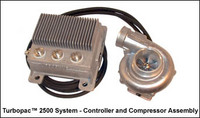Turbodyne Technologies Announces Turbodyne TurboFlow(TM) for Hybrid Applications
VENTURA, Calif., March 14 -- Turbodyne Technologies, Inc. announced today that it has updated the design of its Turbodyne TurboFlow(TM) electronic air injection system for hybrid engine applications.
According to Al Case, CEO, "It's clear that hybrid vehicle production is experiencing significant growth. The biggest challenge is maximizing engine output while maintaining fuel economy. That's where the opportunity lies for the Turbodyne TurboFlow(TM) air injection system."
The Turbodyne TurboFlow air injection system uses an electric motor instead of mechanical linkages to run an air compressor injecting air into an engine system. Eliminating the direct mechanical coupling for a super- or turbo-charger avoids engine power reduction (supercharger) or lack of take-off power (turbo-lag). Hybrid vehicles have electricity in abundance compared with traditional vehicles. The Turbodyne TurboFlow design uses this abundance to provide significant amounts of air-on-demand.
Because the Turbodyne TurboFlow system can run independently of the engine it can be used throughout a driving cycle. The Turbodyne TurboFlow can inject air into small displacement (sub-2000 cc engines), ideal for hybrids, in situations where either power takeoff would drain too much power, or exhaust gas pressure would be insufficient.
The key differences between the new TurboFlow and the existing TurboPac(TM) design are:
* Reduced footprint and weight for the entire assembly
* Secondary "surge" power
* "Smart" controlled compressor output
* Smaller, more efficient motor controller
* Reduced manufacturing time and cost from using "off the shelf"
components
According to Arnold W. Kwong, vice president of research and manufacturing, "Three examples where small-engine vehicles have tough demands are highway passing, freeway on ramps, and leaving a red light. For these situations high demands on electrical drives, mechanical turbo-lag, and supercharger power losses are all difficulties for vehicle designers. The responsiveness of the Turbodyne TurboFlow(TM) system means a surge of power, even for small-displacement engines and hybrids. The 'smart controller' approach of the Turbodyne TurboFlow enables air-on-demand air injection for vehicle designers. Air-on-demand means that fuel-engines can be sized for minimum weight in addition to improving driving cycle performance."
According to Case, "The Turbodyne TurboFlow design means that smaller, lighter engines can be used, in place of larger heavier engines, for many driving cycles. In addition to delivering 'air on demand' without mechanical power losses or exhaust modifications, the units draw virtually no power when not needed."
"According to the J.D. Power and Associates US Hybrid Sales Forecast for the 4th Quarter 2006, total unit volume of Hybrid Vehicle sales in the US is expected to grow to 854,000 units or 4.9% of the total US market by 2011. We forecast that 50% of the hybrid vehicles will be equipped with new versions of air induction systems. This represents a substantial opportunity for Turbodyne."
Case added, "The increase in popularity of smaller displacement and alternative fuel burning engines is creating challenges in the industry. As engine design moves toward smaller and smaller displacement, the need for significantly more air to achieve standard and high performance levels of acceleration in normal vehicle operating conditions increases exponentially. This can only be achieved through independently and electrically controlled air induction. This represents a huge opportunity for Turbodyne to enable independently controlled, electrically powered air induction."
With the press replete with articles about saving gas while losing money (on purchase price), there's a significant opportunity to cut vehicle manufacturing costs by downsizing engines by increasing airflow and thus torque. Downsized engines that produce the same horsepower as larger engines mean lower manufacturing cost and lower retail prices for these vehicles."
About Turbodyne Technologies, Inc.
Turbodyne Technologies, Inc. (TRBD.OB) is a California-based developer of patented electrically powered air movement and propulsion components that are engineered to promote lower fuel consumption and address higher emission standards for hybrid, gas and diesel internal combustion engines.
Their patented TurboPac(TM) design reduces diesel pollution, eliminates turbo-lag in gas and diesel engines and increases fuel economy through both engine downsizing for hybrid, gas and diesel applications as well as low-rpm fuel burn optimization for diesel trucks and busses.
The TurboFlow(TM) design provides computer-controlled, variable high pressure, high volume air movement in a small, lightweight, low power package for a variety of applications from inflatable boat inflation and HVAC air movement to forced air induction for internal combustion engines.



